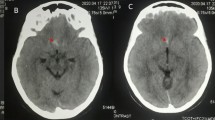Abstract
The concomitant presence of an aneurysm in contact with a sellar lesion usually contraindicates a transsphenoidal approach (TSS). Clipping of an intracranial aneurysm is however possible in highly selected cases also through an endoscopic TSS approach, as long as the basic principles of cerebrovascular surgery are respected. We report thus on a case of a patient harboring a Rathke cleft cyst (RCC) and an aneurysm of the carotid artery (ICA) in close contact with the RCC. The anatomical characteristics of both lesions warranted an endoscopic TSS for removal of the RCC and clipping of the aneurysm during the same approach.


Similar content being viewed by others
References
Bouthillier A, van Loveren HR, Keller JT (1996) Segments of the internal carotid artery: a new classification. Neurosurgery 38:425–432; discussion 432-423
Dehdashti AR, Ganna A, Witterick I, Gentili F (2009) Expanded endoscopic endonasal approach for anterior cranial base and suprasellar lesions: indications and limitations. Neurosurgery 64:677–687 discussion 687-679
Duan Y, Blackham K, Nelson J, Selman W, Bambakidis N (2015) Analysis of short-term total hospital costs and current primary cost drivers of coiling versus clipping for unruptured intracranial aneurysms. Journal of neurointerventional surgery 7:614–618
Fan J, Peng Y, Qi S, Zhang XA, Qiu B, Pan J (2013) Individualized surgical strategies for Rathke cleft cyst based on cyst location. J Neurosurg 119:1437–1446
Froelich S, Cebula H, Debry C, Boyer P (2011) Anterior communicating artery aneurysm clipped via an endoscopic endonasal approach: technical note. Neurosurgery 68:310–316 discussion 315-316
Frontera JA, Moatti J, de los Reyes KM, McCullough S, Moyle H, Bederson JB, Patel A (2014) Safety and cost of stent-assisted coiling of unruptured intracranial aneurysms compared with coiling or clipping. Journal of neurointerventional surgery 6:65–71
Gardner PA, Vaz-Guimaraes F, Jankowitz B, Koutourousiou M, Fernandez-Miranda JC, Wang EW, Snyderman CH (2015) Endoscopic endonasal clipping of intracranial aneurysms: surgical technique and results. World Neurosurg 84:1380–1393
Greving JP, Wermer MJ, Brown RD Jr, Morita A, Juvela S, Yonekura M, Ishibashi T, Torner JC, Nakayama T, Rinkel GJ, Algra A (2014) Development of the PHASES score for prediction of risk of rupture of intracranial aneurysms: a pooled analysis of six prospective cohort studies. Lancet Neurol 13:59–66
Habibi Z, Miri SM, Sheikhrezaei A (2015) Pituitary macroadenoma coexistent with a posterior circulation aneurysm leading to subarachnoidal hemorrhage during transsphenoidal surgery. Turkish neurosurgery 25:469–474
Hadad G, Bassagasteguy L, Carrau RL, Mataza JC, Kassam A, Snyderman CH, Mintz A (2006) A novel reconstructive technique after endoscopic expanded endonasal approaches: vascular pedicle nasoseptal flap. Laryngoscope 116:1882–1886
Han SJ, Rolston JD, Jahangiri A, Aghi MK (2014) Rathke’s cleft cysts: review of natural history and surgical outcomes. J Neuro-Oncol 117:197–203
Jimbo H, Ichikawa M, Fukami S, Otsuka K, Tsurukiri J, Sunaga S, Ikeda Y (2016) Rapid de novo aneurysm formation after Rathke cleft cyst rupture. World Neurosurg 88(690):e611–e696
Kassam AB, Gardner PA, Mintz A, Snyderman CH, Carrau RL, Horowitz M (2007) Endoscopic endonasal clipping of an unsecured superior hypophyseal artery aneurysm. Technical note J Neurosurg 107:1047–1052
Kato T, Sawamura Y, Abe H, Nagashima M (1998) Transsphenoidal-transtuberculum sellae approach for supradiaphragmatic tumours: technical note. Acta Neurochir 140:715–718 discussion 719
Kitai R, Yamauchi T, Arai Y, Hosoda T, Hashimoto N, Tsunetoshi K, Higashino Y, Kikuta KI (2017) Deflation of a Rathke cleft cyst triggered rupture of a superior hypophyseal artery aneurysm: a case report. Br J Neurosurg:1–3
Oh MC, Kim EH, Kim SH (2012) Coexistence of intracranial aneurysm in 800 patients with surgically confirmed pituitary adenoma. J Neurosurg 116:942–947
Pant B, Arita K, Kurisu K, Tominaga A, Eguchi K, Uozumi T (1997) Incidence of intracranial aneurysm associated with pituitary adenoma. Neurosurg Rev 20:13–17
Raper DM, Ding D, Evans E, Starke RM, Crowley RW, Liu KC, Oldfield EH, Jane JA, Jr. (2017) Clinical features, management considerations and outcomes in case series of patients with parasellar intracranial aneurysms undergoing anterior skull base surgery. World Neurosurg 99:424–432
Rustagi T, Uy EM, Rai M, Kannan S, Senatus P (2011) Intracranial hemorrhage from undetected aneurysmal rupture complicating transphenoidal pituitary adenoma resection. Conn Med 75:393–398
Takeuchi S, Wada K, Sakakibara F, Nawashiro H, Mori K (2013) Anterior cerebral artery dissecting aneurysm associated with untreated craniopharyngioma. Br J Neurosurg 27:102–104
Tsuchida T, Tanaka R, Yokoyama M, Sato H (1983) Rupture of anterior communicating artery aneurysm during transsphenoidal surgery for pituitary adenoma. Surg Neurol 20:67–70
Yamada S, Yamada SM, Hirohata T, Ishii Y, Hoya K, Murakami M, Matsuno A (2012) Endoscopic extracapsular removal of pituitary adenoma: the importance of pretreatment of an adjacent unruptured internal carotid artery aneurysm. Case Rep Neurol Med 2012:891847
Yu K, Herwadkar A, Kearney T, Gnanalingham KK (2011) Pituitary adenoma and incidental superior hypophyseal aneurysm. Br J Neurosurg 25:432–433
Author information
Authors and Affiliations
Corresponding author
Additional information
Comments
The authors describe a case report of concomitant Rathke cyst removal and SHA aneurysm clipping. One could argue that the Acom aneurysm has a higher risk of bleed albeit small (and should have also been treated during the same setting). Then exposure of Acom is not quite more complicated once the suprasellar cistern is exposed. Also the addition of a binostril technique offers a much better maneuverability of instruments, and most importantly dealing with potential bleeding if it occurs. In larger medial carotid aneurysms, the best segment of carotid for proximal occlusion is the cavernous segment (C4). The presented case report has worked beautifully in their hand but attention to the criticism above is important for more complex cases.
Amir Dehdashti
NY, USA
This article is part of the Topical Collection on Vascular Neurosurgery - Aneurysm
Electronic supplementary material
ESM 1
(MP4 182,821 kb)
Rights and permissions
About this article
Cite this article
Serra, C., Sebök, M., Widmer, L. et al. Clipping of a superior hypophyseal artery aneurysm during endoscopic transnasal removal of a Rathke cleft cyst: a case report. Acta Neurochir 161, 197–201 (2019). https://doi.org/10.1007/s00701-018-3728-0
Received:
Accepted:
Published:
Issue Date:
DOI: https://doi.org/10.1007/s00701-018-3728-0



